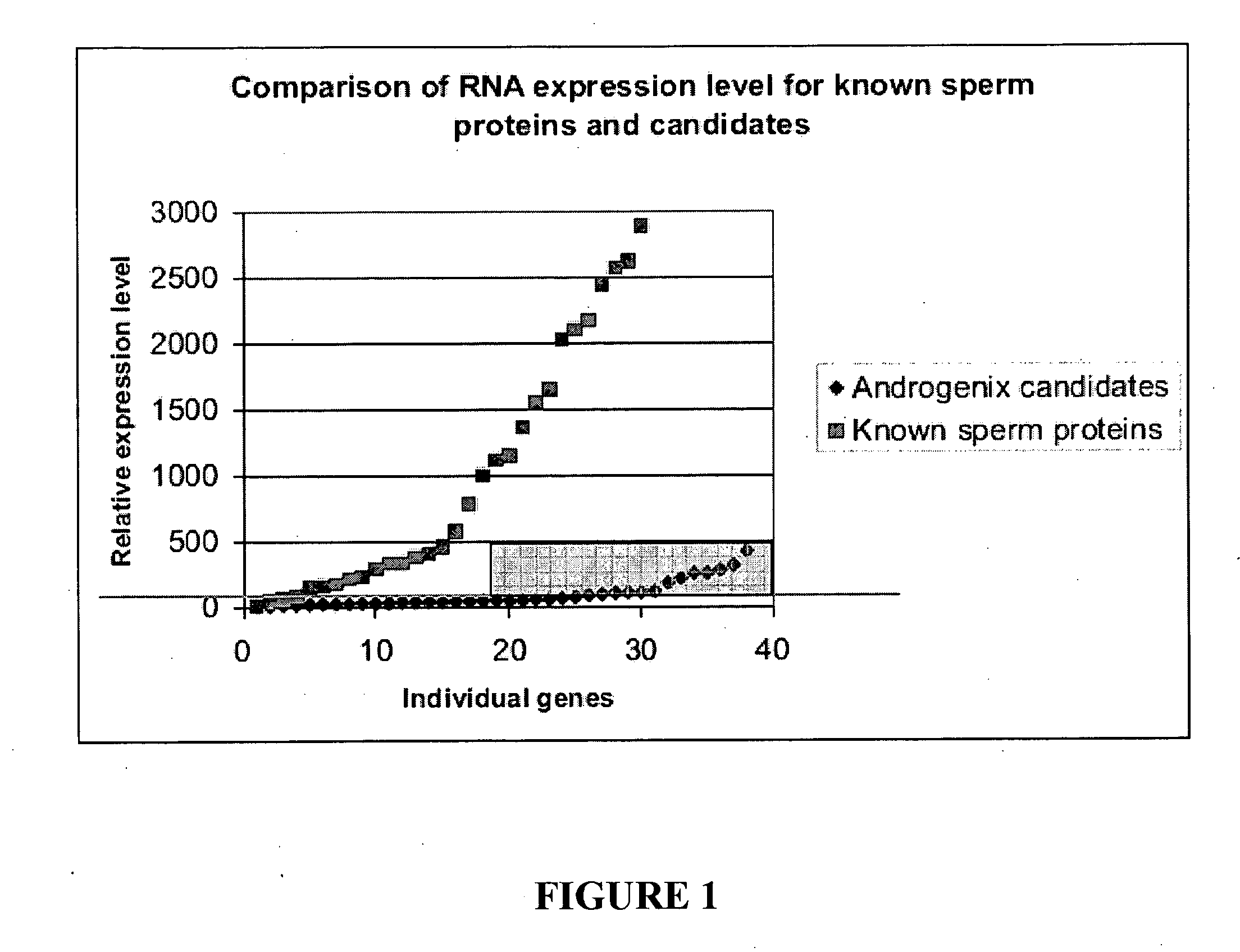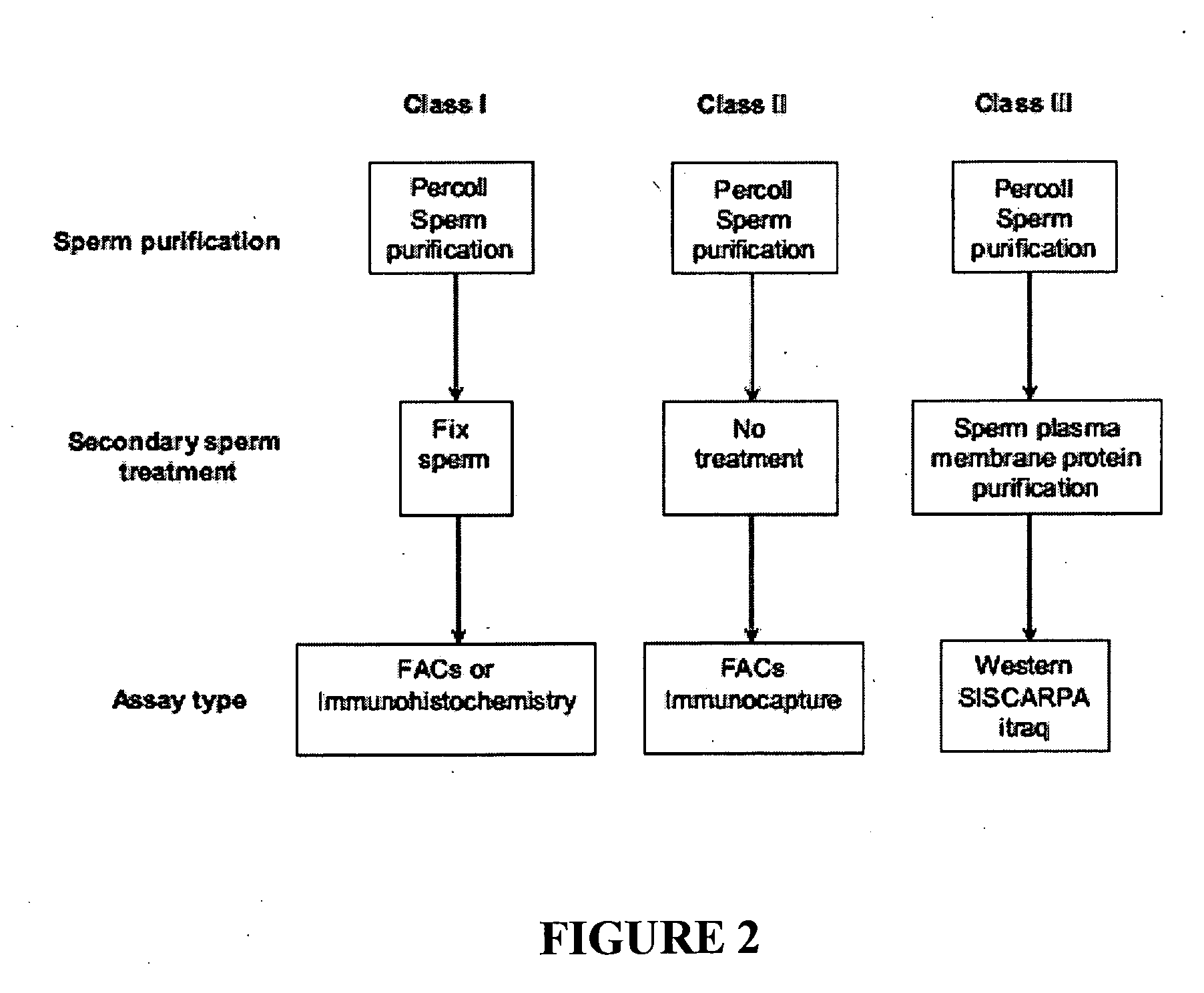Materials and methods for sperm sex selection
a sperm sex and material technology, applied in the field of sexspecific antigens, can solve the problems of inability to easily scale, limited genetic improvement rate, limited technique, etc., and achieve the effects of high specificity, high sensitivity, and high sensitivity
- Summary
- Abstract
- Description
- Claims
- Application Information
AI Technical Summary
Benefits of technology
Problems solved by technology
Method used
Image
Examples
example 1
Identification of Candidate Genes by Bioinformatics
[0055]The publicly available bovine genome (available on the Ensembl website; originally released on Aug. 14, 2006; updated version released in February 2007) together with the publicly available human genome, was used in a genomics based method to identify differences on the surface of sexed semen. Specifically, candidate genes were selected using the Ensembl Biomart tool (available on the Ensembl website) and the following strategy:
[0056]1) identify bovine orthologues of human X chromosome genes that have a transmembrane domain using Biomart and check by manual analysis;
[0057]2) identify genes in the bovine genome that are present on the X chromosome and have a transmembrane domain by Biomart and check by manual analysis (no sequenced bovine Y chromosome); and
[0058]3) identify bovine orthologues of human Y chromosome genes that have a transmembrane domain using Biomart and check by manual analysis (one bovine gene was included tha...
example 2
Prioritization of Candidate Genes Based Upon Expression Levels
[0060]Each candidate gene identified in Example 1 was examined to see if there were splice variants and if so, an exon common to all transcripts was selected. If no suitable exons were present, an exon unique to each transcript was selected for primer design. Exons were employed for primer design, instead of across introns, to allow all the primers to be verified on genomic DNA. Control primers were also designed to ensure the absence of genomic DNA in the cDNA. Primers were designed for real-time PCR using the Primer3 software (available on-line from SourceForge) with a product size of 80-150 bp. All primers were checked using the Blast software to confirm that they could not prime elsewhere in the genome (i.e. that at least the 3′ end base of the primer could not match). The designed primers were then employed in reverse transcription PCR studies to analyse expression of the candidate genes in bovine testis tissue cDNA ...
example 3
Prioritization of Candidate Genes Based Upon Subcellular Localization
[0066]The low level expression of the candidate genes in round spermatids suggests that, if a candidate resides solely on a membrane other than the cell surface, then these candidates should be given a lower priority. The reason for this action is that, as the candidates already have low expression, this coupled with only a small percentage of the protein being on the surface would make the candidate very difficult to detect. The candidate genes, or their orthologues in other species, were therefore examined to determine the subcellular location of the gene product. If evidence was available that the protein was on a membrane system other than the cell surface, this candidate was given a lower priority. This data was combined with the round spermatid expression data to generate four gene classes of differing priority, with Class I being the highest priority. Each of the Class I bovine candidate genes, which are ide...
PUM
| Property | Measurement | Unit |
|---|---|---|
| Fraction | aaaaa | aaaaa |
| Fraction | aaaaa | aaaaa |
| Fraction | aaaaa | aaaaa |
Abstract
Description
Claims
Application Information
 Login to View More
Login to View More - R&D
- Intellectual Property
- Life Sciences
- Materials
- Tech Scout
- Unparalleled Data Quality
- Higher Quality Content
- 60% Fewer Hallucinations
Browse by: Latest US Patents, China's latest patents, Technical Efficacy Thesaurus, Application Domain, Technology Topic, Popular Technical Reports.
© 2025 PatSnap. All rights reserved.Legal|Privacy policy|Modern Slavery Act Transparency Statement|Sitemap|About US| Contact US: help@patsnap.com



